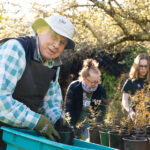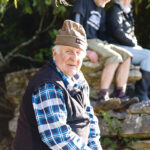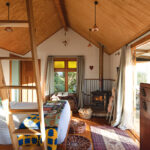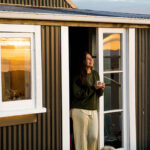Moa bones, caves and velvet worms: Explore the prehistoric treasures at this family’s Waitomo farm
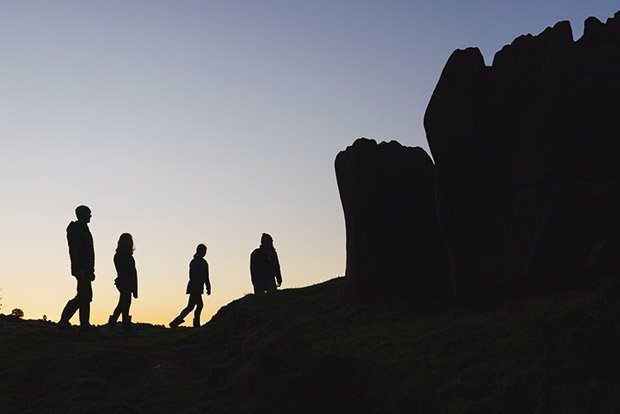
A spirited Waitomo clan have filled their lives with art and adventure, exploring every nook and cranny of their region and sharing some of its best bits with visitors.
Words: Jane Warwick Photos: Tessa Chrisp
Nearly 60 years ago, Ann Jago visited New Zealand after her tour as a member of the English Women’s Cricket team. Little did she know then that a Kiwi farmer would bowl her over and that she would eventually go into bat for three children. She had even less idea that those children would go rambling in a subterranean playground with moa bones as their playtime props — if she even knew what a moa was.
She knows now. She knows about moa, extinct giant penguins, prehistoric shark’s teeth, incredible giant snails, how to spell speleology and not to panic when her children go bouldering or when they disappear into the bush with torches. She also understands that there are teeny-tiny native orchids that get her stoic husband, Alister, all misty-eyed. She knows without a doubt that in a country that is spoilt with fabled terrain, she has landed somewhere special in Waitomo in the King Country.
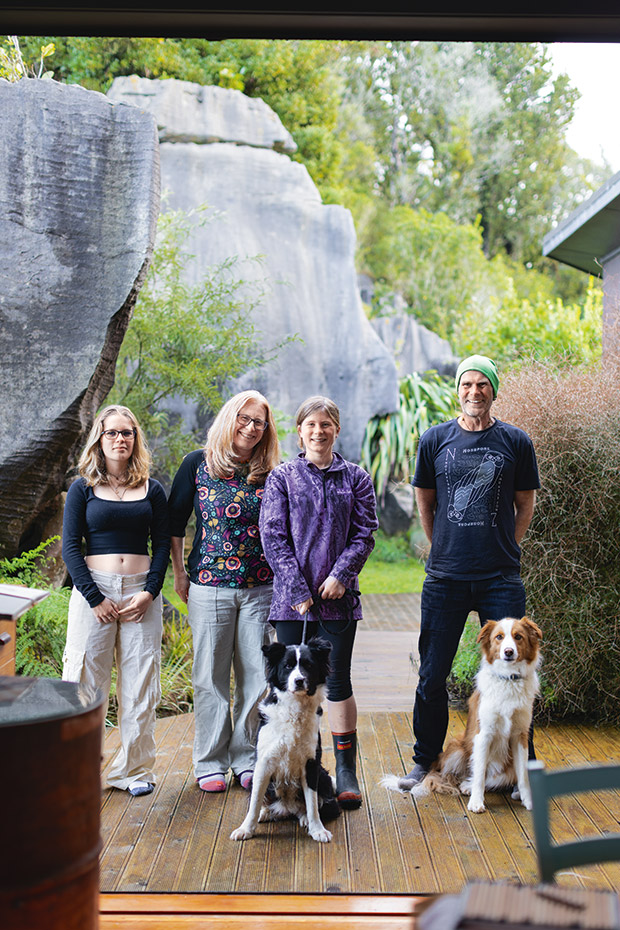
In the lee of these rocks is where Biddy Stubbs and Rich Kersel host their musical events with a little help from (left to right) Hazel and Fern, supervised by their canine pals Leif and Fig.
Her daughter, Biddy Stubbs and sons, Angus and Ben Stubbs, know, too. How could they not when every way they turn the Waitomo landscape — with rolling hectares of bush on top and pockmarked limestone below — fans out beneath them? It’s a backdrop that rearranges every hour — this way under the sun, the other in the rain; here in the breeze, there in that.
And in the very beginning, did the first Stubbs on this land, Hugh, who took over as farm manager in 1914, realize what a treasure it was? When he arrived, the paddocks were littered with felled trees.
The surname “Stubbs” is purported to come from the Anglo-Saxon for an area covered by tree stumps, so perhaps such a landscape, from deep in the mists of his DNA, was not so abstract? But more than 100 years later, with the Stubbs family now owners of the land and not employees upon it, the sweeping hectares of deep Aotearoa-green foliage prove that slash and burn has long gone.
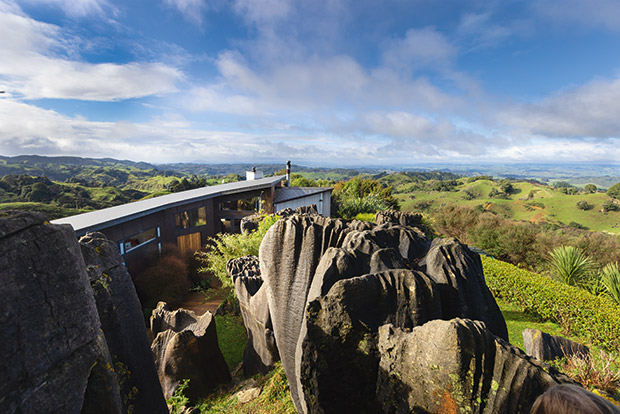
Biddy and Rich’s house is set among the limestone sedimentary rock delineating the area’s geology. If the Stubbs really want to define their place in the grand scheme of things, they need only look at the surface of those rocks to see the fragments of fossils and shells millions of years old. That certainly puts perspective on their current place in the planet’s history.
If the landscape is remarkable, what lies underneath is even more extraordinary. A network of limestone caves echoes and drips beneath the farm and throughout the district. Although known to Ngāti Maniapoto, the caves were unexplored by iwi. Then, in 1887, rangatira Tāne Tinorau and English surveyor Fred Mace braved the maw of the most well-known cave, Waitomo (after which the district is named), and journeyed deep into the cavern on a flax raft, their path lit only by candlelight.
They were very much flabbered and even more gasted, not least by the myriad, magical lights of glow worms. Tane Tinorau realized that this was something they shouldn’t keep to themselves. He started Waitomo’s first tourism business, and several of his descendants still work there today.
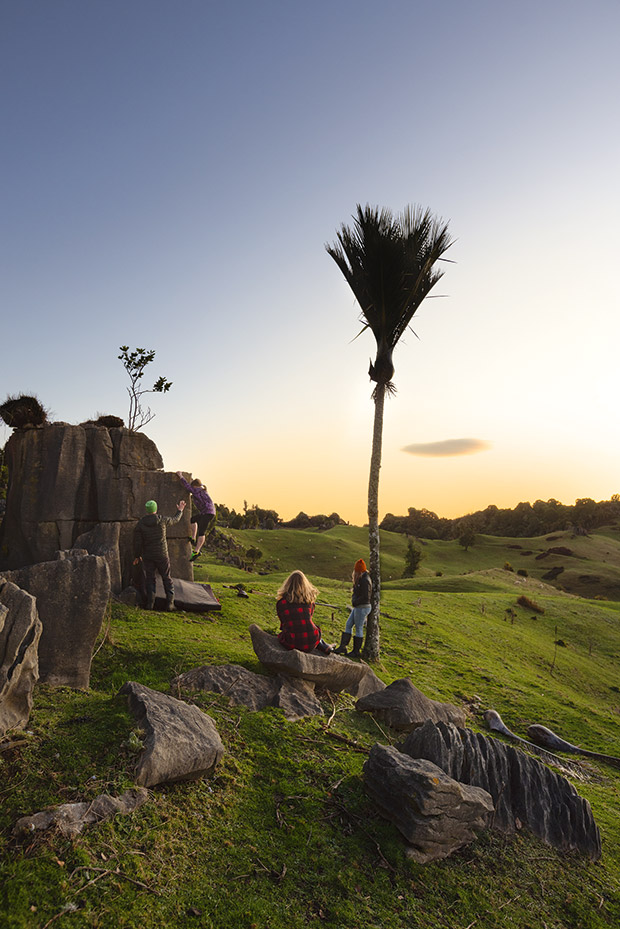
Biddy, Rich, Hazel, Fern, Leif and Fig never tire of the landscape in any weather. The constantly changing light casts a variety of perspectives in an environment that, even with farming and one-time tree felling, is little changed from when moa roamed.
Up the road on the Stubbs’ farm, Hugh’s descendants — Alister, Antony, Ben, Angus and Biddy and their respective spouses — also believe the area’s grandeur should be shared and have taken great strides in achieving this. Of course, they have had a head start from all that careering through the landscape as children. They know the nooks; they know the crannies.
They were always finding and exploring new caves. They found moa bones taller than themselves; the skeletons of 40 kākāpō, a now-critically endangered parrot. They camped among the stalagmites and under the stalactites and squeezed through narrow fissures. They shuddered when faced with long-legged cave wētā and batted away other insects. They dangled precariously on the ends of ropes to see if a newly discovered tomo (hole) really was access to a new cave.
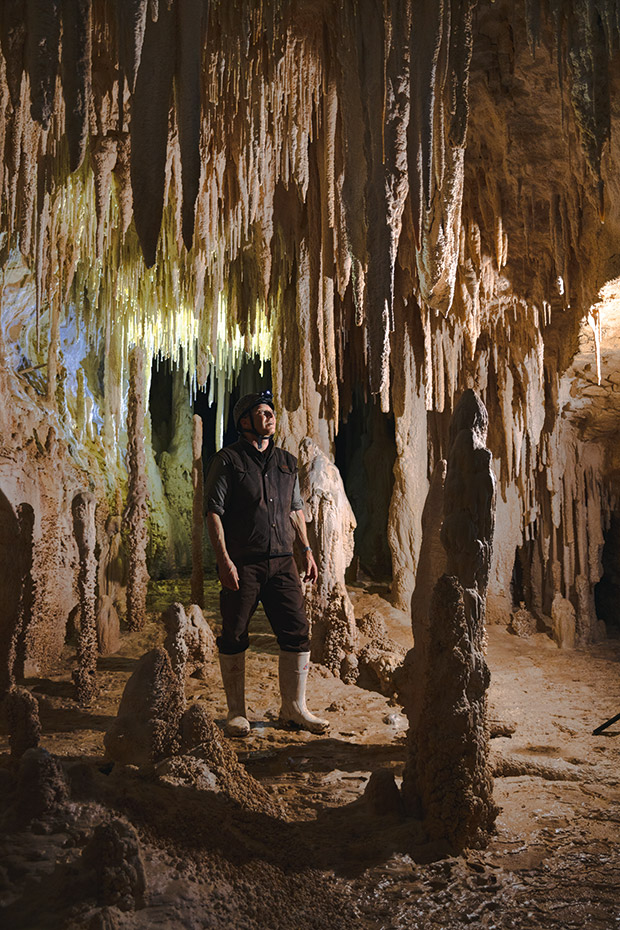
Angus, underground at work in an ‘office’ to rival all offices.
They did archaeological digs by candlelight, bringing home bones for Ann to reassemble, a jigsaw to beat all jigsaws. While their friends lived vicariously via Famous Five and Swallows and Amazons books, the Stubbs children were the Five and the Blackett and Walker children.
Now that they are adults, they want their children — Fern, Hazel, Elijah, Edan, Zarah, Max, Pippin and their cousins, the fifth generation of Waitomo Stubbs — to be the Harry, Hermione, Ron, Sam and Frodo of their age.
After a lifetime on the farm, they are still excited and enthusiastic about their surroundings. Their conversation tumbles around the room. “If you took all the vegetation off, you would see the terrain is like the tray you buy eggs in…,” starts Biddy’s husband, Rich Kersel. “What about when….?” interrupts Biddy. “Oh, yes. When Dad…” interjects Angus. “Went missing!” finishes Ben and rolls his eyes. Alister looks abashed; Ann seems exasperated.
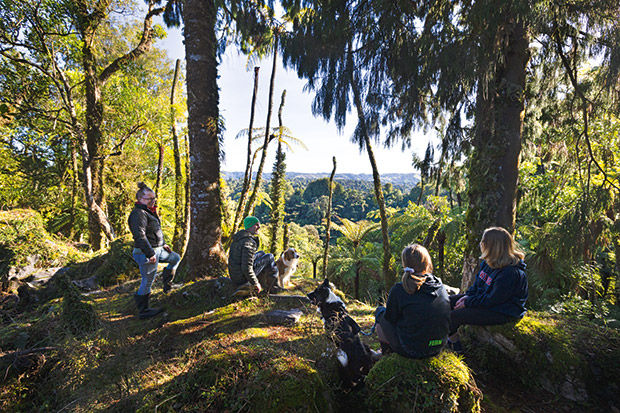
Perhaps she still hasn’t forgiven him for the day he went off to work on a track without telling anyone, failed to turn up to the dinner table and was eventually found indignant and broken after much frantic searching. It is undecided whether his leg or his ego took the more significant beating.
His ill-fated track is just one of several crisscrossing the farm, and there is always room for more. Most of us spent the pandemic lockdowns tucked up in front of the telly binge-watching and binge-eating. Biddy, Rich — an outdoor education and P.E. instructor — Hazel (14) and Fern (12) bushwacked their way through the undergrowth, creating a track for a 75-minute walk (called the Misty Mountain). They also developed the Rocks Track for a half-hour amble.
“It was fun,” laughs Biddy. “And it gave us something to do instead of being confined to the house. We were lucky; we had just over 674 hectares to be ‘locked down’ on.” Fern sitting on the carpet, her feet propped up on her skateboard, looks dubious about the adjective “fun” for all that hard work, but is sensible enough not to say anything.
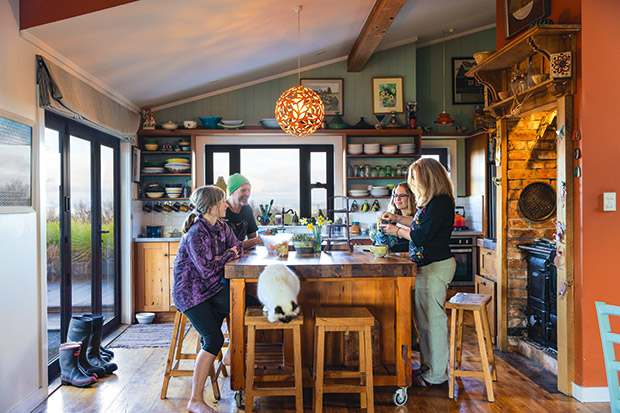
Around the kitchen table, the foursome (and Mr Tumnus, the cat) are looked down on by artwork by various family members.
The Rocks Track goes through an integral part of the Stubbs’ farm. In 1982, more than a third of the property was put into a Queen Elizabeth Trust Covenant to preserve its native flora and fauna. The independent body partners with landowners to preserve and protect private land, and the Stubbs Family Covenant is now regularly visited by scientists, botanists, geologists and other assorted -ists as a rare pristine research laboratory.
It is not only -ists who benefit. The farm hosts programmes for school children that combine abseiling, caving and teambuilding. It is also part of the route of the Waitomo Trail Run and a playground and base for cavers, climbers and boulderers.
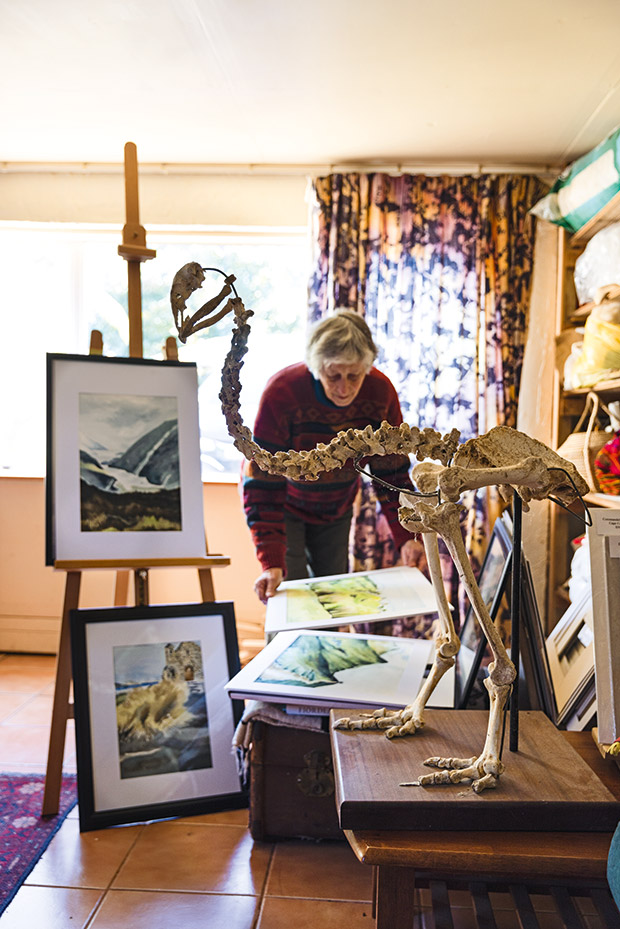
Ann in her studio with one of the moa skeletons she has meticulously assembled, surrounded by her art.
The family also holds Stubbs Days organized by the Museum of Caves (waitomocaves.com), where apart from the physical activities, visitors also collect native seeds. These are passed on to Jan Simmons, a propagator dedicated to the ecological restoration of native forests and wetlands. The seeds collected for Jan to sprout are eventually planted back on the farm during Stubbs Days, infilling the bush.
Leaving the area to the whims of nature untouched by man’s folly has also allowed Alister and Ben to study and monitor another thing they are passionate about — clean water. “This farm,” explains Ben, “is unusual in that the headwaters of four tributaries rise here — the Mangapōhue, Marokopa, Moakurarua and Waitomo streams. We have fenced nearly every stream, and it is extraordinary how clean the water has become.”
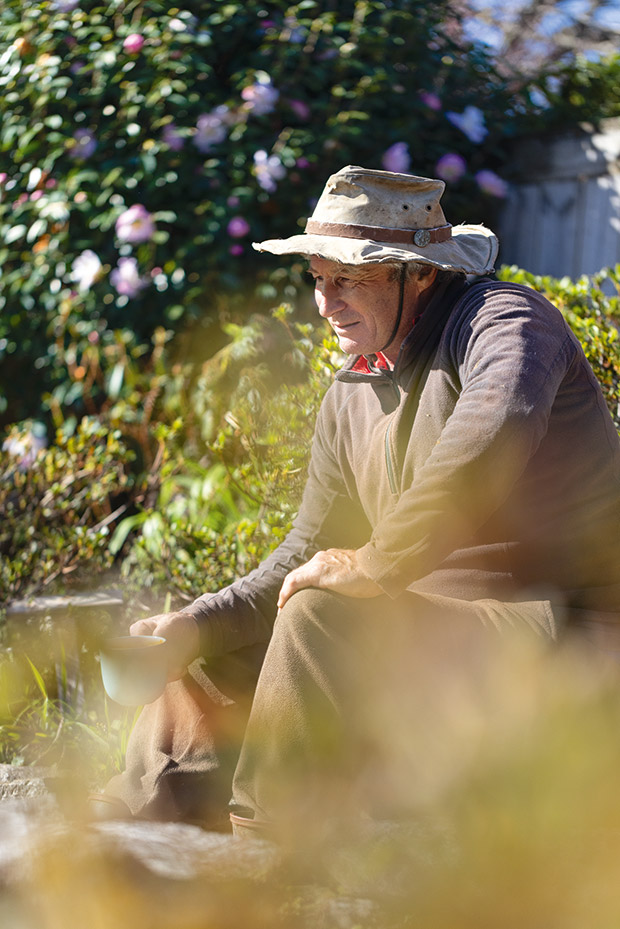
Ben, being contemplative — he hears the wind as a chord and sees the landscape in verse.
It’s hard to differentiate work from leisure on the Stubbs’ farm; there is arrant enjoyment in all they do. But one activity where the fun is far more than the work needed to organize it are the musical concerts Biddy and Rich hold in their backyard, which is landscaped around existing limestone monoliths. Performers have included noted musicians Paul Ubana Jones, Ciaran McMeeken and Graeme James.
An added sweetener for visiting artists is that they get to stay at Rock Retreat, the little B&B down the drive. It is an off-grid traditional mountain hut made from recycled materials and built by Biddy and Rich, the income from which allows Biddy to spend more time on her other great love — art.
- Uncle Alister helps in the propagation and preservation of native flora.
- Uncle Antony takes a breather.
- Bex is also heavily influenced by the environment in her art (how could she not be?), and her current joy is drawing native birds in pastel.
From the top of Misty Mountain, the Stubbs can see as far as Mount Ruapehu, almost as far as the sea rolling onto the west coast, inland for too many kilometres to count and north across the rolling King Country to Mount Te Aroha and the Firth of Thames.
It’s all out there, but for four generations of this family, for all the travel, the adventures, and the other lives they have lived outside of the family farm, all they want or need is right here.
THE VELVET WORM
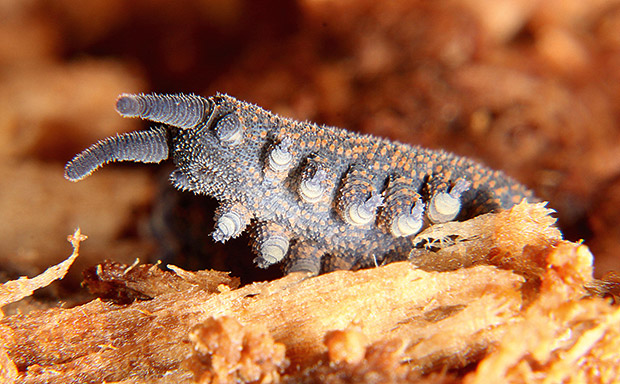
One of the rare creatures found on the Stubbs’ farm is the velvet worm or peripatus. Inching around the floor of the bush, they are little changed in 500 million years. They look a bit like caterpillars and have short legs in pairs down their length. They are reportedly not well understood by scientists, but one of their attractions is that they are like worms and insects and are regarded as a kind of missing link in the study of these species.
ALL IN THE FAMILY
Biddy, Angus and Ben have all returned to the family farm to settle in houses spread across the property. Ben runs the farm; Biddy and her husband Rich have Rock Retreat; and Angus and his wife Rach operate Te Tiro B&B and work for Waitomo’s famous Black Water Rafting Co.
Much of their downtime is consumed by their artistic endeavours — a family trait handed down by Ann, who recently held her first solo exhibition. It was a bit of a set-up. Her family had told her for years that she should be exhibiting, but Ann always dismissed the idea. “Recently, the children decided we should hold a joint exhibition, which I agreed to, only to find that all along they had planned that it would only be my work on display. I had to go along with it; it was too late to back out. I was flattered to sell some of my works.”
- The design of Biddy and Rich’s small B&B, Rock Retreat, is based on a traditional New Zealand mountain hut.
- It was built with recycled materials, and is solar-powered (rockretreat.co.nz).
- Travel blogger Bianca Sweden from @kiwisoffcourse, who stayed at Rock Retreat recently, enjoys the sun while doing a spot of “research”.
Ann’s parents were full-time artists and passed that talent onto her — her choice is watercolour. Biddy studied textile design and silversmithing at the Otago School of Art, works across all mediums, and is particularly interested in portraiture. Ben studied ceramic sculpture at the same school and is a poet and musician, while his wife, Bex, is an art teacher. She is presently experimenting with a pastel, gold leaf and hand-stitching combination. Angus’ hobby is photography.
The Stubbs family art is available for sale. There are three studios minutes apart on the farm, all of which can be visited on request.
Love this story? Subscribe now!
 This article first appeared in NZ Life & Leisure Magazine.
This article first appeared in NZ Life & Leisure Magazine.
